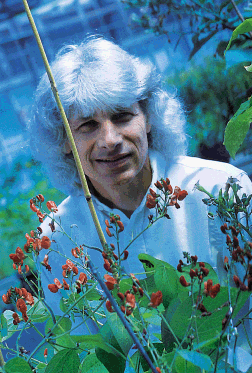|
Robert Goldberg dreams of a postmillennial farming--with superraces of corn, wheat and rice, plants producing industrial oils in their leaves, crops that clone themselves. Yields enough to feed the hungriest continents. Can four-pound tomatoes and bell peppers the size of basketballs be far behind? The genetics and developmental biology underlying these possibilities have already assumed a suitably futuristic name-"genomics"-- and one of the new science's foremost practitioners is professor Bob Goldberg of UCLA's Department of Molecular, Cellular and Developmental Biology. The research of Goldberg and his colleagues may one day help feed the entire planet. "I'd say about 30 percent of agricultural crops are genetically engineered now," says Goldberg. "Within 10 years, it will be 100 percent. Plant gene hunters and engineers are working on products that will have an impact 10, 15 years from now."
 very story of scientific discovery deserves one great image: Brother Mendel poised over his bean sprouts, Barbara McClintock browsing her piebald cornstalks. The image for Goldberg hangs right on his office wall: It is a dark form, evocative as any Goya, of what could be a pair of blunt butterfly wings, black against a black background, and fringed with quicksilver flecks. In reality, it is an enlarged cross-section of the tobacco plant anther, the stemlike male sex organ in the plant. The flecks are mRNAmolecules which have just been synthesized. It is an image encapsulating the very essence of plant life. "When I saw the picture, I knew I had something," smiles Goldberg. "I'd never seen anything like it before."
very story of scientific discovery deserves one great image: Brother Mendel poised over his bean sprouts, Barbara McClintock browsing her piebald cornstalks. The image for Goldberg hangs right on his office wall: It is a dark form, evocative as any Goya, of what could be a pair of blunt butterfly wings, black against a black background, and fringed with quicksilver flecks. In reality, it is an enlarged cross-section of the tobacco plant anther, the stemlike male sex organ in the plant. The flecks are mRNAmolecules which have just been synthesized. It is an image encapsulating the very essence of plant life. "When I saw the picture, I knew I had something," smiles Goldberg. "I'd never seen anything like it before." Nor had anyone else. What Goldberg, who had been studying plant genes since the 1970s, had found was a set of tobacco genes that switched on at the same time and in the same cell type during the development of male sex organs. These cell types are critical for the production of pollen, which contains the plants' sperm cells. Soon afterward, Goldberg presented this discovery at a conference in Ghent, Belgium. "Later, a man approached, very excited, and said, 'that specificity is incredible,'" recalls Goldberg. "Next thing I know, we're walking down the street to my favorite candy store in Ghent and he says, 'Perhaps we could form a collaboration and use your genes to make male-sterile individuals in a very clever way.' " Goldberg's interlocutor was Jan Leemans, the manager of research and development of the ag-biotech company called Plant Genetics Systems (PGS). In seed-bearing crops such as corn, wheat and rice, each flower contains both male and female sex organs, the anther and pistil, and these plants can pollinate themselves. That is not good news for farmers: The result is fields of hopelessly inbred grain, crops that are not only physically fragile but also nutritionally anemic compared to the best hybrids, which contain the best genes from the two inbred varieties.
|

